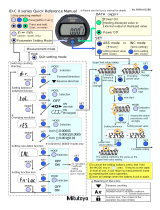
iii
Chapter 6 Statistical Graphs and Calculations
1. Before Performing Statistical Calculations .................................................................... 6-1
2. Calculating and Graphing Single-Variable Statistical Data ........................................... 6-4
3. Calculating and Graphing Paired-Variable Statistical Data ........................................... 6-9
4. Performing Statistical Calculations .............................................................................. 6-15
5. Tests ........................................................................................................................... 6-22
6. Confidence Interval ..................................................................................................... 6-35
7. Distribution .................................................................................................................. 6-38
8. Input and Output Terms of Tests, Confidence Interval, and Distribution .................... 6-50
9. Statistic Formula ......................................................................................................... 6-53
Chapter 7 Financial Calculation (TVM)
1. Before Performing Financial Calculations ..................................................................... 7-1
2. Simple Interest .............................................................................................................. 7-2
3. Compound Interest ........................................................................................................ 7-3
4. Cash Flow (Investment Appraisal) ................................................................................ 7-5
5. Amortization .................................................................................................................. 7-7
6. Interest Rate Conversion .............................................................................................. 7-9
7. Cost, Selling Price, Margin .......................................................................................... 7-10
8. Day/Date Calculations ................................................................................................. 7-11
9. Depreciation ................................................................................................................ 7-12
10. Bond Calculations ....................................................................................................... 7-14
11. Financial Calculations Using Functions ...................................................................... 7-16
Chapter 8 Programming
1. Basic Programming Steps ............................................................................................. 8-1
2. PRGM Mode Function Keys .......................................................................................... 8-2
3. Editing Program Contents ............................................................................................. 8-3
4. File Management .......................................................................................................... 8-5
5. Command Reference .................................................................................................... 8-7
6. Using Calculator Functions in Programs ..................................................................... 8-21
7. PRGM Mode Command List ....................................................................................... 8-37
8. Program Library .......................................................................................................... 8-42
Chapter 9 Spreadsheet
1. Spreadsheet Basics and the Function Menu ................................................................ 9-1
2. Basic Spreadsheet Operations ..................................................................................... 9-2
3. Using Special S • SHT Mode Commands .................................................................... 9-14
4. Drawing Statistical Graphs, and Performing Statistical and Regression
Calculations ................................................................................................................. 9-15
5. S • SHT Mode Memory ................................................................................................ 9-20
Chapter 10 eActivity
1. eActivity Overview ....................................................................................................... 10-1
2. eActivity Function Menus ............................................................................................ 10-2
3. eActivity File Operations ............................................................................................. 10-3
4. Inputting and Editing Data ........................................................................................... 10-4
5. eActivity Guide .......................................................................................................... 10-13
Chapter 11 Memory Manager
1. Using the Memory Manager ........................................................................................ 11-1




















